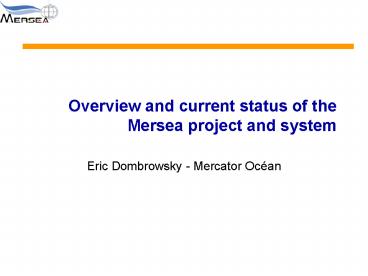Overview and current status of the Mersea project and system - PowerPoint PPT Presentation
Title:
Overview and current status of the Mersea project and system
Description:
Uses altimeter data, SST and sea-ice concentration & drift data ... Agreement between NERSC and National Meteorological Institute: Terms and ... – PowerPoint PPT presentation
Number of Views:29
Avg rating:3.0/5.0
Title: Overview and current status of the Mersea project and system
1
Overview and current status of the Mersea project
and system
- Eric Dombrowsky - Mercator Océan
2
The MERSEA Integrated Project
- Development of a European system for operational
monitoring and forecasting of the ocean physics,
biogeochemistry, and ecosystems, on global and
regional scales - A European Commission FP6 Project (Space-GMES)
- 4-year project (2004 2008)
- 38 contractors, 16 countries
3
Work Breakdown Structure
- 13 workpackages
- WP1 coordination IFREMER, France
- 3 WPs dedicated to input data
- 2 WPs for system design and assessment, and for
information system activities - 2 WPs for RD modelassim and evaluation
- 2 WPs for implementation and production including
downscaling - 2 WPs for service and demonstrations special
focus experiments and user involvement oil and
gas industry, ship routing and waves, oil spill
drift - WP13 overall asessment
4
MERSEA Project Participants
Norway met no NERSC Spain
CSIC IEO Turkey IMS UK
NERC-SOC Ocean Numerics PML NERC-POL The Met
Office Univ. Reading Univ. Southampton Internatio
nal ECMWF
- Cyprus
- FDMR
- Denmark
- DMI
- U.E
- JRC
- Finland
- U-HEL
- France
- ASP
- BOOST
- CLS
- CNRS
- Ifremer
- Mercator Océan
- Germany
- AWI
- GeoB
- IFM/Univ. Kiel
- IFM/Univ. Hamburg
- Greece
- HCMR
- Ireland
- Techworks
- Italy
- CNR-ISAC
- CNR-ISSIA
- CoNISMA
- ENEA
- INGV
- OGS
EuroGOOS members Operational agencies or
services providers
5
The MERSEA Integrated System, a European
capacity for Ocean Monitoring and Forecasting
Bologna Emilia Romagna Copenhagen Oresund Berge
n Hordaland Exeter Devon Toulouse Midi-Pyrénées
6
Area 3 Arctic
Area 4 Baltic
Area 2 North East Atlantic
Area 5 Med Sea
Area 1 Global
7
Mersea Development
- We are currently in the Target Operational Period
2 TOP2 - 6 month period starting in April 2007
- System has evolved from V0 (start of the project)
to V1 for TOP1 (Oct 2005), and to version 2 for
TOP2, final version 3 will be completed in April
2008 - V0 was the preexisting patchwork (Apr 2004)
- V1 transformed this patchwork into a network
(Oct 2005) - Scientific improvements
- Coordination of validation activities
- Sharing of tools and expertise
- Development of the information management system
- Links to users through development and
demonstration of services - V2 made it evolve towards an real integrated
system (Apr 2007) - Downscaling from global to regions with boundary
data provision - Links to common data providers
- More homogeneous data delivery
- V3 is the target fully integrated system (Apr
2008) - Full integration from global to regions
- Links to users through services
- Starting point for MyOcean
8
NERSC Arctic system Version v.2 content and
status
- HYCOM 11-16 km configuration with sea-ice model
for Arctic and North Atlantic - Weekly operation
- analyses 14-day forecasts
- Ensemble Kalman filter assimilation scheme
- Uses altimeter data, SST and sea-ice
concentration drift data - Does not use in situ TS profile data
- Further development of v.2 for v.3
- Work on nesting of TOPAZ into global Mersea
system has started
9
NERSC Arctic system Developments for version v.2
- Agreement between NERSC and National
Meteorological Institute Terms and conditions of
operations of TOPAZ at Met.No. Concluded 30
March 2007 - Ice drift velocity data assimilation implemented
- Higher horizontal resolution 11-16 km replacing
18-36 km - Ecosystem simulation shown to be relatively
insensitive to assimilation of altimeter data - Port of system to new super-computer
10
DMI Baltic system Version v.2 content and status
- 3NM North Sea 0.5 NM Danish Strait
configurations - DMI version of BSH c-mod ocean sea-ice model
- Three configurations coupled by two-way nesting
- Twice daily operation
- forecasts to 60 hours ahead
- SST assimilation scheme
- Lateral boundary data in North Sea from
climatology
11
DMI Baltic system Developments for version v.2
- Increased resolution
- Doubled horizontal resolution and improved
vertical resolution - North Sea grid spacing 3NM (5km) in horizontal
2 m in vertical - Danish Straits grid spacing 0.5 NM (900 m) 1 m
- Mixing parameterizations
- Horizontal dissipation revised to avoid current
divergence - K-W vertical mixing scheme represents breaking
surface internal waves - Much sharper pycnocline obtained at some stations
- Attempted to use lateral boundary data from
north-east Atlantic - Problems because of differences in bathymetry in
Norwegian Trench (recall that models use s-coords
and hence are smoothed) - SST data assimilation implemented
- uses simplified Kalman filter (Larsson et al
2007) - System optimized for AMD Opteron computer
12
INGV Mediterranean system Version v.2 content
and status
- 1/16o, 72 level configuration (with revised
Atlantic domain) - NEMO ocean models with 72 layers
- Daily forecasts and weekly analysis updates
- 10-day forecasts
- Multi-variate 3D variational assimilation scheme
- Uses in situ TS profile data SST analysis
- Uses SSH data with revised Rio MDT
- Nesting into to global system
- Mechanics for nesting in global model have been
set up - A parallel version is run nested in v.2 global
13
INGV Mediterranean system Developments for
version v.2
- Converted ocean model from OPA 8.1 to NEMO
- Preparations to nest within Mercator global
system - New assimilation scheme
- multi-variate 3D variational scheme (with some
novel approaches) - Uses in situ TS, SST, SSH
- Revisions to mean dynamic topography

